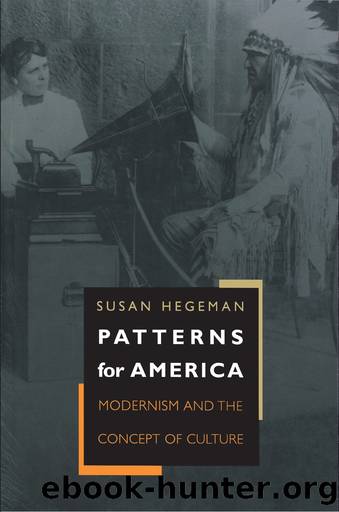Patterns for America by Hegeman Susan;

Author:Hegeman, Susan;
Language: eng
Format: epub
Publisher: Princeton University Press
Published: 2023-06-15T00:00:00+00:00
Middle West, Middlebrow, Middletown
Out of this momentâs highly politicized cultural landscape, an interesting convergence of the two competing narratives of cultural difference began to emerge. In effect, the class-based version of difference would be lined up with the regionalist account in such a way that one region, the Midwest, became synonymous with the middle (bourgeois) stratum of cultural taste. As we shall see, this convergence had a certain political power on both sides of the cultural debate, and from both sides of the geographic divide. While elites in the urban centers were thus justified in maintaining their traditional disdain of the provincial (nicely summed up by New Yorker editor Harold Rossâs slogan for his sophisticated urban magazine: âNot for the old lady in Dubuqueâ), Midwesterners too found a kind of comfort in the association. Turning the negative stereotype into a more positive sign of identity, some would embrace the âmiddlebrowâ label as a sign of its antielitist American authenticity. Like their heir, Garrison Keillor, regionalist cultural boosters of the Midwest would murmur back a defensive, âWe like it here.â Before addressing the Midwestern response to this interesting convergence between images of the Midwest and the idea of middlebrow taste, the link must first be explained in terms of both historical conditions and the cultural imagination of the period.
Pierre Bourdieu reminds us that âhighbrowâ and âmiddlebrowâ tastes are both indigenous to the dominant classes, but that they are derived from different portions of the bourgeoisie. The first (âlegitimateâ culture) belongs to people secure in both their economic and cultural capital, while the other (culture moyenne) belongs to members of a still-ascending fraction of the middle class, who are, hence, insecurely reverential of a high culture to which they still have limited access. As with the distinctions between high and low culture generally, the difference between highbrow and middlebrow tastes is a question of social distance from the centers of cultural production. Thus, to Bourdieu, the quintessential products of middlebrow taste are âcultural intermediariesâ such as film adaptations of works of âlegitimateâ literature and symphonic âpopsâ concerts, which fill the gap, as it were, in the social-cultural hierarchy.23
In the 1930s United States, such cultural intermediaries abounded, reflecting the social aspirations of many middle-class Americans. But their ubiquity also reflects the uneven national distribution of cultural resources. As with the Sears catalogue for the prairie farmer, it is easy to see how much more important cultural outlets such as the Book-of-the-Month Club, the Chautauqua and Lyceum lecture circuits, or the CBS Radio Orchestra would have been to cultural consumers living outside of major cities.24 And even among cities, there were few that could support an active community of artists whose livelihoods did not depend on providing such âcultural intermediaries.â Though Chicago had been an important market hub since before the turn of the century, and in the 1920s had a thriving arts scene, even the artists of the âChicago Renaissanceâ eventually made their bid for national prominence in New York, the location of
Download
This site does not store any files on its server. We only index and link to content provided by other sites. Please contact the content providers to delete copyright contents if any and email us, we'll remove relevant links or contents immediately.
| Ancient & Classical | Arthurian Romance |
| Beat Generation | Feminist |
| Gothic & Romantic | LGBT |
| Medieval | Modern |
| Modernism | Postmodernism |
| Renaissance | Shakespeare |
| Surrealism | Victorian |
4 3 2 1: A Novel by Paul Auster(11790)
The handmaid's tale by Margaret Atwood(7448)
Giovanni's Room by James Baldwin(6809)
Asking the Right Questions: A Guide to Critical Thinking by M. Neil Browne & Stuart M. Keeley(5356)
Big Magic: Creative Living Beyond Fear by Elizabeth Gilbert(5352)
Ego Is the Enemy by Ryan Holiday(4957)
On Writing A Memoir of the Craft by Stephen King(4663)
The Body: A Guide for Occupants by Bill Bryson(4583)
Ken Follett - World without end by Ken Follett(4443)
Bluets by Maggie Nelson(4261)
Adulting by Kelly Williams Brown(4234)
Eat That Frog! by Brian Tracy(4149)
Guilty Pleasures by Laurell K Hamilton(4116)
White Noise - A Novel by Don DeLillo(3829)
The Poetry of Pablo Neruda by Pablo Neruda(3815)
Fingerprints of the Gods by Graham Hancock(3738)
Alive: The Story of the Andes Survivors by Piers Paul Read(3730)
The Book of Joy by Dalai Lama(3697)
The Bookshop by Penelope Fitzgerald(3619)
